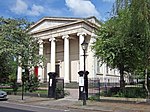Gambier Terrace

Gambier Terrace (Liverpool, England) is a street of 19th-century houses overlooking St. James's Mount and Gardens and Liverpool Cathedral. It is generally reckoned to be in Canning, although it falls within the Rodney Street conservation area, together with Hope Street and Rodney Street. It was named after James Gambier. Numbers 1 to 10 are Grade II* Listed Buildings, as is the northernmost house in the terrace, which has the address of Canning St around the corner. They were probably designed by John Foster, Junior. The terrace was built in 1832–1837. It was originally planned that the entire row would be built in a single style but construction was halted in the slump of 1837, and the demand for large city houses declined as the middle class moved out to the new suburbs. Number 10 was the last of the original build. The terrace was later completed to a cheaper specification. During the First World War Number 1 Gambier Terrace was the location of the Women's War Service Bureau which assisted soldiers and their families. The service expanded into 5 additional premises on Bold Street and Berry Street.In the 1950/60's Nos:11-12 Gambier Terrace was home to the Liverpool Art High School, the junior section of the Liverpool College of Art. The students were aged 13-16 years of age who won scholarships to attend the school. Cynthia Lennon was a student there before she met John Lennon. Also a student there was Peter Chang (1944–2017) he was a British artist known for his distinctive jewellery. He later trained as a graphic designer and sculptor at the Liverpool College of Art. He won the Liverpool Senior City Scholarship in 1966 which enabled him to study in Paris at Atelier 17 under S.W. Hayter. From the 1980s onward, he focused on jewellery-making. His collection was featured in Rifat Ozbek’s 1987 fashion show. His work is in collections around the world, including the Victoria and Albert Museum, the Metropolitan Museum of Art, and the Cooper Hewitt. John Lennon of The Beatles lived at 3 Gambier Terrace in 1960 with former Beatles bassist Stuart Sutcliffe after Sutcliffe asked the others who lived there, including fellow student and future well-known artist Margaret Chapman if the homeless Lennon could move in. They all attended nearby Liverpool College of Art. The freehold to the terrace and the garden in front belongs to Liverpool City Council. The land adjacent to Hope Street is maintained, in part, by the City Council and the leaseholders. The exact status of this land is unclear except that it is a public thoroughfare and unadopted by the City Council's highways department.
Excerpt from the Wikipedia article Gambier Terrace (License: CC BY-SA 3.0, Authors, Images).Gambier Terrace
Gambier Terrace, Liverpool Georgian Quarter
Geographical coordinates (GPS) Address Nearby Places Show on map
Geographical coordinates (GPS)
| Latitude | Longitude |
|---|---|
| N 53.398 ° | E -2.971 ° |
Address
Gambier Terrace 20
L1 7BL Liverpool, Georgian Quarter
England, United Kingdom
Open on Google Maps









